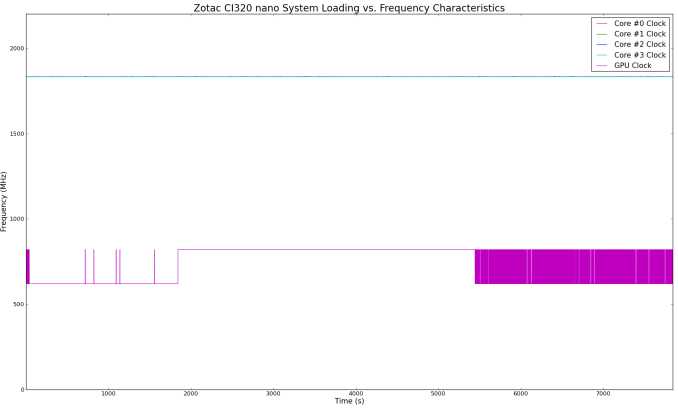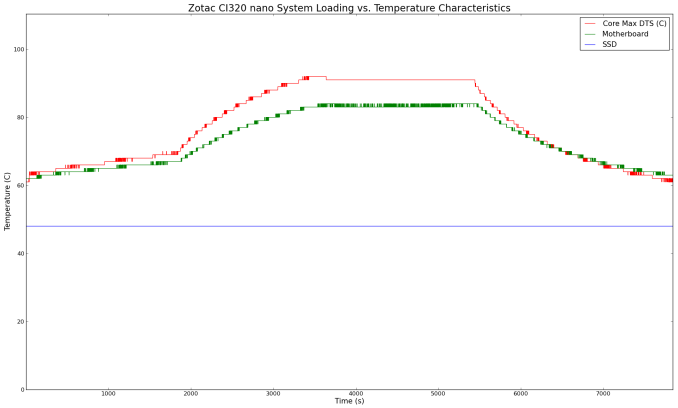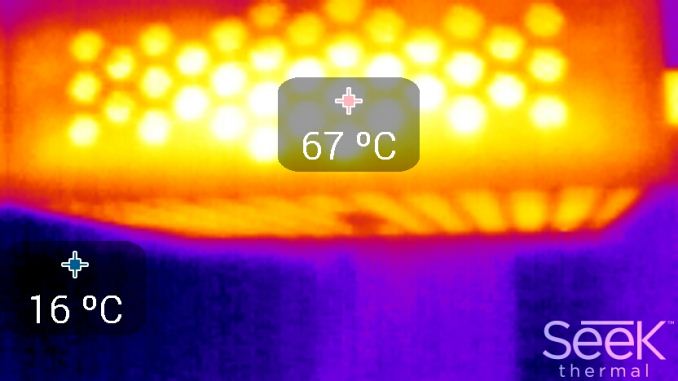Zotac ZBOX CI320 nano Review: A Fanless Bay Trail-M mini-PC
by Ganesh T S on January 6, 2015 10:00 AM ESTPower Consumption and Thermal Performance
The power consumption at the wall was measured with a 1080p display being driven through the HDMI port. In the graphs below, we compare the idle and load power of the Zotac ZBOX CI320 nano with other low power PCs evaluated before. For load power consumption, we ran Furmark 1.12.0 and Prime95 v27.9 together. The numbers are not beyond the realm of reason for the combination of hardware components in the machine.


Reasonable power aside, there does seem to be a BIOS default configuration issue causing the idle power to be a bit on the high end. One of the possible reasons was revealed in our evaluation of the thermal performance (discussed below).
The various clocks in the system as well as the temperatures within the unit are presented below. We start with the system at idle, followed by 30 minutes of pure CPU loading. This is followed by another 30 minutes of both CPU and GPU being loaded simultaneously. After this, the CPU load was removed, allowing the GPU to be loaded alone for another 30 minutes.
A look at the frequencies above indicates that all the cores are pegged at 1.83 GHz throughout our evaluation (even at idle). On the other hand, the GPU frequency varies between 600 and 800 MHz depending on the GPU load. The junction temperature of the Celeron N2930 is 100 C. The cooling system is efficient and manages to keep the SoC temperature below 93 C even under extreme duress.
Another important aspect to keep note of while evaluating fanless PCs is the chassis temperature. Using Seek Thermal's thermal imager, we observed the chassis temperature after the CPU package temperature reached the steady state value in the above graph.
Surprisingly, the chassis temperature was less than 70 C even after heavy loading. Though this is not as low as the 56 C we observed in the CA320 nano, it is better than the 75 C+ that we saw in the CI540 nano.













44 Comments
View All Comments
Pissedoffyouth - Tuesday, January 6, 2015 - link
I built me a mini itx the size of a bible recently, with a 65w AMD APU (A10-7800). With the L9a cooler unless under a heavy gaming load its inaudible. I recommend if your looking for a tiny PC for office work but also gaming go down that route as the performance is much better than these bay trail NUC's and similar cost.BackInAction - Tuesday, January 6, 2015 - link
What case/MB did you use?Pissedoffyouth - Wednesday, January 7, 2015 - link
Minibox m350 - the smallest case you can get. Motherboard was Asrock A88 itx - has msata which was a plus as I had no space for SSDThe_Assimilator - Tuesday, January 6, 2015 - link
Maybe the performance is much better *because it consumes 8 times more power*. And there is no way that you're not experiencing throttling, if indeed you have been foolish enough to cram an AMD APU into a bible-sized enclosure.Samus - Tuesday, January 6, 2015 - link
BRIX and NUC are still amazing. We're talking 4"x4" and power on-par with a mainstream desktop, here.That being said, ITX is the largest format I consider anymore. My Xeon E3-1231 workstation has an Asus H87 ITX board, 16GB RAM, 480GB SSD, 6TB HDD, 2TB 2.5" HDD, NVidia GTX970, 450-watt PSU and liquid cooling built in the Silverstone FT03-mini. Although it's aluminum it weighs quite a bit just because it's literally packed...not enough room inside to fit a balled-up fist.
But it's ultra-fast, 24/7 reliable and the size of a loaf of bread.
NUC/BRIX is mainstream fast, 24/7 reliable and the size of a sandwich.
Antronman - Saturday, January 10, 2015 - link
"Workstation build""H87"
"GTX970"
Just because you use a computer for work does not make it a workstation.
ITX isn't something everybody is interested in, because either they don't care about how much space their computer takes up or they need expansion room. Really, small form-factor PCs are a small niche. Otherwise you'd see a much larger variety in ITX boards, and a drive to make components much, much smaller.
As for the GTX 970, unless it has the MSI ITX variant, the card itself is the size of a sandwich.
StevoLincolnite - Monday, January 12, 2015 - link
Move over to Socket 2011, 64Gb+ Ram then you have a workstation.I laugh at your quad-core xeon and only 16Gb of Ram.
However, you can't get that much performance in ITX.
Pissedoffyouth - Wednesday, January 7, 2015 - link
It is throttling, but only under heavy gaming and I only game at 1280x1024 so it still works great. Day to day tasks never get the temps high at alljohnny_boy - Tuesday, January 6, 2015 - link
That must be an enormous bible you have in mind. Even at 45W, there is no way god damned hell you're getting an A8/10 series APU into a bible-sized enclosure.Samus - Tuesday, January 6, 2015 - link
He must be talking about those bibles that sit on a pedestal that weigh 30 lbs :)